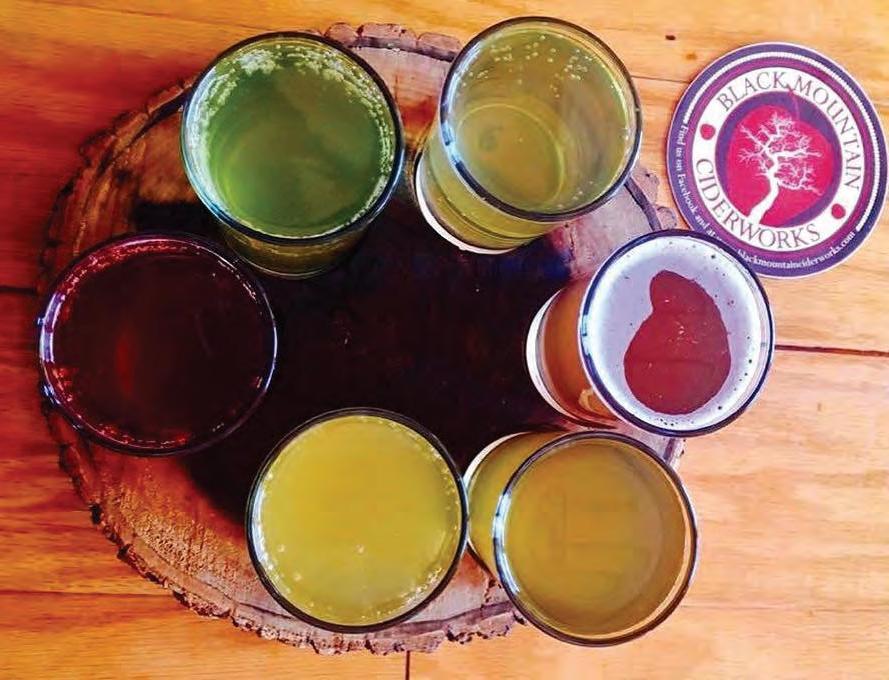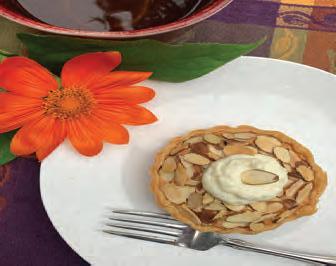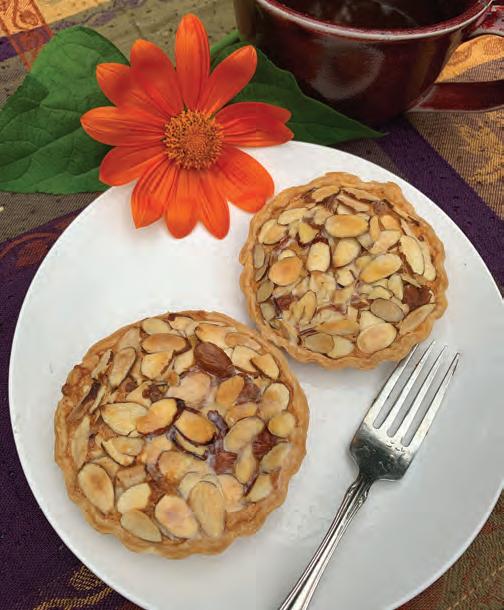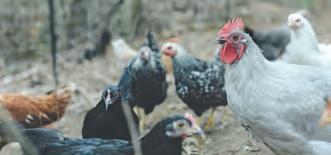
18 minute read
On the House
from 2020-11-REC
Success Recipes for


How NC entrepreneurs are making small food brands big business


Story and photos by Wendy Perry
Having the entrepreneur gene is both a blessing and a curse.

I hear my sweet Mama’s voice in my head often, when she looked at me once years ago, during the middle of a crazy catered event, elbow deep in soap suds washing chafing pans. She said: “Just what makes you want to do this right here!?”
Bless her sweet soul. “Mama,” I said, “I just don’t know, and can’t help myself! I got it from Daddy.”
There are scores of food artisans around North Carolina who “just can’t help themselves,” bringing the best of the best into the marketplace. Here’s the story of four, and their recipes for success.
Little Black Dressing Company
High Point littleblackdressing.com

Strolling through your grocery store produce section, if you’ve not found it yet, take a closer look and see if you find some Little Black Dressing Co. salad dressings. Winning both NC and national awards and accolades, LBD is one of North Carolina’s best-kept secrets. These delicious dressings are tucked on the chilled produce shelf since they are made fresh, refrigerated and shipped that way right into the store. You won’t find a lot of “stuff” in them either (no preservatives, additives, and they’re gluten-free).
Creator and “head salad dressing maker” Kissie Stroup knows a thing or two about taking a family recipe from home to market from her days growing up with her Grandma Nana’s delicious vinaigrette on fresh-fromthe-garden salads. Nana made her dressing for school and church gatherings, and Kissie wanted to share it with others. She started making the dressing and selling in small batches in 2008. In 2013, her husband said: “Instead of selling dressing to friends from our porch, let’s do this thing.”
“I was fortunate my husband was supportive, and I had this opportunity to make dressing, contribute to my family and give back to my community,” Kissie adds.
Her first dressing was a tweak of Nana’s, Dreamy Creamy Vinaigrette. From there, she added others and her company was born. Little Black Dressing Co. has grown, is sold across America, and offers private
labeling too. And the name? “Well, like a good little black dress, it goes with everything!”
Kissie’s recipe for Success
“Tenacity. And willingness to work hard. My business model was slow, calculated and paid as I went along to avoid debt. It has proven to work for me and that’s my best advice!”
Mimi’s Mountain Mixes
Hendersonville mimismountainmixes.com

As soon as you meet Lin JohnsonCarlson, you just need to know more about this spunky grandmother of 12!
Years ago, her grandkids started calling her Mimi, so it was only fitting she name her company Mimi’s Mountain Mixes. Here’s how her recipes work: Just open a box, stir in a beer or other carbonated beverage, and after a few short minutes of baking you are enjoying any one of her simply prepared products. Along with her Old Tavern Beer Bread Mix, there are biscuits, soft pretzels, cakes, pancakes and more, including some gluten-free goodies, too.
Mimi’s was launched in 2008, when Lin found herself divorced, in big debt and facing foreclosure like so many others during the recession. Bouncing from friends’ homes to homes, and even time in a shelter, Lin didn’t let her spirit and desire to move forward keep her down, finding the blessings in her time of despair.
Taking inspiration from her Grandma Ruth, she was able to borrow church kitchens in Florida and Ohio, where she got busy creating her mixes. With her recipe laced with optimism, she worked tirelessly out and about at flea and farmers’ markets, turning things around, while developing a following of loyal customers — all the while, giving back to help other women who found themselves in similar situations.
continued on page 24
Lin’s recipe for Success “Keep that chin UP! Take every blessing and multiply it. Mimi’s Mountain Mixes continues to offer a step up for women who are in shoes Lin has worn, and with each purchase of her products, customers are helping her and this mission.“
NEVER SEAL YOUR WOOD OR CONCRETE AGAIN PERMANENT ONE-TIME SOLUTION
BEFORE

25% OFF WITH THIS AD AFTER


BEFORE
• We clean, restore & permanently preserve your product. • Prevents wood from rotting, decaying and further damage from moisture. • Repels mold, mildew & fungus growth. • Prevents concrete from pitting, flaking, dusting and scaling. • Prevents salt & alkali damage. • Backed by technology.
AFTER

Free Estimates 844.481.6862 PermaSealUSA.com
C
M
Y
CM
MY
CY
CMY
K
Tips from the Pros
5 take-aways and ingredients of a recipe for success
1. What you think the consumer wants and will buy and what they actually want and will buy are not always the same. 2. Be willing to make changes and adapt product(s) to meet consumer needs, not just yours. 3. This is not easy. This is hard. Do not get discouraged. Stick-to-itiveness required! 4. Favorite thing to do? New product development! Least favorite? Paperwork! Be prepared for lots of necessary paperwork and paper trails to keep track of. 5. Love what you do and give back — to staff in allowing time for family life balance, and to community. Share your success and blessings with others in need or less fortunate.

Wendy’s bonus tip:
“Having created and managed many of my own companies over the years, a certain amount of sheer craziness is required.”

10oz Pecan Brittle-F.pdf 1 11/22/19 4:43 PM

Elizabeth’s Pecans
Turkey elizabethspecans.com
Pecan Products
You read that right — Alan Bundy’s pecan shop is in the town of Turkey, in Sampson County. It’s worth your while to get off onto the backroads and see what you come across there. Alan’s little gem of a shop awaits you, just a bit off Interstate 40 on Highway 24.
Alan’s father, Navy Captain Bobby F. Bundy, established a pecan grove in 1981 and later started B&B Pecan Processors of NC. Alan has taken the farm and the processor to new places. The pecans, grown there in Turkey, are processed locally and shipped around the world. They can be found in more than 140 major grocery store chains, smaller boutiques and are available for fundraising events.
After B&B Pecans launched back in the ’90s, their now famous “Elizabeth’s Exceptional Pecan Brittle” (named after Alan’s daughter) came along in 1998. Different from most, this buttery brittle is a soft-crunchy, making it easy to eat and their biggest seller. Since then, Alan has added more tasty pecan products, for a total of 14 roasty toasty pecan treats for Elizabeth’s fans.
Elizabeth’s has a quaint little shop by the railroad tracks in Turkey, where folks from all over the country (and world) drop by to sample most all of their pecan treats. Storekeeper Anita will graciously offer them to you, and wow, does that lady love her job! She can tell you all sorts of things about their pecans, the company and all the many other local products there in the store, including many from veteran owned companies.
carolinacountry.com/extras Here’s a pizza with a healthy boost thanks to chicken & four vegetables. White Tango Pizza substitutes a boring red sauce for a dressing from Little Black Dressing Co., “It Takes Three to Tango,” containing ranch, 1000 island and blue cheese. Find it online. Alan’s recipe for Success Alan focuses on maximizing ideas and resources that continue to produce the best handmade products his customers love and enjoy.
1 in 6 Snacks
Raleigh 1in6snacks.com

When you’re raised in a home where your family is in the snack business, what do you do when you grow up? Why, you jump right in with the family. The snack family.
While still a fulltime agri-business management student at NC State University, Josh Monahan started working on his first product in 2015, potato chips. It was then he realized 1 in 6 people in the United States don’t even know where their next meal is coming from. He knew right away that would be the flagship name of his product and his brand: 1 in 6 Snacks.
Launched in 2016, his first product line (and perhaps most familiar) was Carolina Kettle. These flavorful “outrageously crunchy” chips start with the best potatoes, kettle fried in small batches with sunflower oil, and uniquely seasoned with Carolina herbs and spices. Oh, and they’re preservative- and gluten-free too.
With a dozen tasty chip varieties now being made, Carolina Kettle’s most popular are Sea Salt and Down East Carolina BBQ (Josh’s favorite is “Southern Twang” salt and balsamic vinegar). Newcomers to the 1 in 6 Snacks family include: Pine State Popcorn, Rustic Roots tortilla chips and salsas, and Memaw’s Country Kitchen cookies and cheese tiddies.
Josh’s recipe for Success Giving back. “Our customers appreciate our philosophy and that we set aside donations from every bag of chips we sell towards entities that help feed those 1 in 6 looking for their next meal. When seeing that on our bags, that helps customers make a purchase decision while [the bags] are in their hands.”
Wendy Perry, a culinary adventurist and blogger, chats about goodness around NC on her blog at WendysHomeEconomics.com.
CLOG-FREE GUTTERS OR YOUR MONEY BACK GUARANTEED!
THE NATION’ S GUTTER GUARD1

15% OFF
YOUR ENTIRE LEAFFILTER PURCHASE* Exclusive Offer – Redeem By Phone Today!
ADDITIONALLY 10% OFF SENIOR & MILITARY DISCOUNTS
CALL US TODAY FOR PLUS! 1-844-440-9814 A FREE ESTIMATE THE FIRST 50 CALLERS WILL RECEIVE AN ADDITIONAL 5% OFF FINANCING THAT FITS YOUR BUDGET! 1Subject to credit 1 LIFETIME WARRANTY www.LeafFilter.com/15off Promo Code: 73 YOUR ENTIRE INSTALL! **Offer valid at estimate only approval. Call for details. 2The leading consumer reporting agency conducted a 16 month outdoor test of gutter guards in 2010 and recognized LeafFilter as the “#1 rated professionally installed gutter guard system in America.” *For those who qualify. One coupon per household. No obligation estimate valid for 1 year.
A D V E R T I S E M E N T Clogged, Backed—up Septic System…Can anything Restore It?
DEAR DARRYL: My home is about 10 years old, and so is my septic system. Dear Dear I have always taken pride in keeping my home and property in top shape. In DarrylDarrylfact, my neighbors and I are always kidding each other about who keeps their home and yard nicest. Lately, however, I have had a horrible smell in my yard, and also in one of my bathrooms, coming from the shower drain. My grass is muddy and all the drains in my home are very slow.
My wife is on my back to make the bathroom stop smelling and as you can imagine, my neighbors are having a field day, kidding me about the mud pit and sewage stench in my yard. It’s humiliating. I called a plumber buddy of mine, who recommended pumping (and maybe even replacing) my septic system. But at the potential cost of thousands of dollars, I hate to explore that option.
I tried the store bought, so called, Septic treatments out there, and they did Nothing to clear up my problem. Is there anything on the market I can pour or flush into my system that will restore it to normal, and keep it maintained? DEAR CLOGGED AND SMELLY: As a reader of my column, I am sure you are aware that I have a great deal of experience in this particular field. You will be glad to know that there IS a septic solution that will solve your back-up and effectively restore your entire system from interior piping throughout the septic system and even unclog the drain field as well. SeptiCleanse® Shock and Maintenance Programs deliver your system the fast active bacteria and enzymes needed to liquefy solid waste and free the clogs causing your back-up.
This fast-acting bacteria multiplies within minutes of application and is specifically designed to withstand many of today’s anti-bacterial cleaners, soaps and detergents. It comes in dissolvable plastic packs, that you just flush down your toilets. It’s so cool. Plus, they actually Guarantee that it restores ANY system, no matter how bad the problem is.
SeptiCleanse®Shock and Maintenance Programs are designed to work on any septic system regardless of design or age. From modern day systems to sand mounds, and systems installed generations ago, I have at personally seen SeptiCleanse unclog and restore these systems in a matter weeks. I highly recommend that you try it before spending any money on repairs. SeptiCleanse products are available online www.septicleanse.com or you can order or learn more bycalling toll free at 1-888-899-8345. If you use the promo code “NCS11”,you can get a free shock treatment, added to your order which normally costs $169. Make sure to use that code when you call or buy online.
Orange Sweet potatoes pack a punch in North CarolinaSuperfood By Margaret Buranen | Photos courtesy of the NC SweetPotato Commission

North Carolina grows more sweet potatoes than any other state. Let that sink in. Our state’s total annual crop amounts to half of all of the sweet potatoes grown in the United States.
They sweeten the state’s economy, too. The 94,000 North Carolina acres where they are grown yielded a crop worth $324 million in 2019. Some of the largest NC sweet potato growers have offices in the United Kingdom for exports there and Europe.
This is a hot time of year for sweet potatoes, our state vegetable, but uses for the flavorful root vegetables are not limited to holiday table side dishes.
“Sweet potatoes stand up to all kinds of cuisines and food types, from smoothies to vegetable tacos,” says Michelle Grainger, the North Carolina SweetPotato Commission’s executive director. Working on behalf of the commission’s more than 400 sweet potato growers, Michelle keeps up with national food trends. While she grew up in NC enjoying “my grandma’s sweet potato soufflé,” Michelle has started branching out, eating sweet potatoes in dishes that aren’t desserts.
“I love the flavoring sweet potatoes give to ethnic foods — Indian, Mexican, Spanish dishes,” she says.
Her current favorite ways to eat sweet potatoes are tater tots and a savory dish that features sweet potatoes and crabmeat with melted cheese on top.
“On a fall or winter day, that dish is phenomenal,” she says.
Several varieties of sweet potatoes are grown in NC. They vary in color and taste. The most popular variety by far is Covington, developed at NC State University.
Covington is the only sweet potato variety grown at Tull Hill Farms in Kinston in Lenoir County. Co-owners Rob Hill and his dad Kendall Hill are members of Pitt and Greene Electric Cooperative. Rob’s cousin, Michael Hill, is also a partner in the farming operation.
For Rob Hill, growing sweet potatoes is a legacy.
“My great grandfather grew sweet potatoes. Then my grandfather started growing more of them,” he explains.
Sweet potato plants, aka slips, are transplanted into the soil from late May until about July 1. Some slips come from a greenhouse grower, who buys his stock from NC State. These plants are known as G1 (Generation One).
Small sweet potatoes saved from last fall’s harvest (then G1) are planted whole, around March 15. The slips they produce (called G2, for Second Generation) are also transplanted into growing fields starting in late May.
Harvesting comes about 100 days after the slips were planted. Around Labor Day, the farm workers first verify that the crop is ready to be harvested. They dig up sweet potatoes by hand in two or three separate sections, 10 or 12 feet into the field.
The plants, now grown to about two feet high, are shredded. Then a chain digger machine is used to go under each row of plants. It lays the potatoes on the ground. Workers pick them up by hand and load them on trucks for transport to the farm’s warehouse where they will be sorted.
The just-harvested sweet potatoes spend several days in the heated warehouse. This curing process heightens their sweetness. Then they are cooled (by air conditioning or ambient air, if the temperature is low enough). They can be stored in the warehouse for months without losing their flavor.
Rob says the biggest changes in sweet potato growing in the last 10 years are the export market and sweet potatoes for French fries.
“[For a typical acre’s yield], 45 percent of the sweet potatoes will be sold to supermarkets. Twenty-five percent will go to food processing companies for French fries,” he explains. “Ten percent will [be saved to] make seed potatoes for next year’s crop. The remaining 20 percent we try to get value for somehow or donate to food pantries.”
The sweet potato is surprisingly versatile. It’s big business for farmers across the state. But Michelle has learned that, just as people often don’t realize these sweet potato facts, they also aren’t aware of what a healthy food they are.
“The level of nutritional value out of sweet potatoes is huge,” she notes. “They are one of the top ‘superfoods.’”
Margaret Buranen writes from her home in Kentucky.

Get great sweet potato recipes at ncsweetpotatoes.com/recipes. Want to learn more? Find K–12 lesson plans at ncsweetpotatoes.com/curriculum.
Crape Myrtles of Winter Some varieties sport flashy winter bark
Story and photos by L.A. Jackson
Late autumn is a good time to add trees and shrubs to the landscape, and one perennial favorite for North Carolina gardeners is the crape myrtle. Once established, it becomes a dependable beauty that blooms like crazy through the long, hot summer months. Crape myrtle’s fall foliage show can be flashy as well, but, after that, it dulls visually through the winter months.
But this doesn’t have to be the case.
The crape myrtles that originally came to America’s colonies from China and Korea in the mid-1750s were Lagerstroemia indica — flowering floosies, for sure, but, come winter, their bare gray branches blended in with the rest of the bland landscape.
However, in the 1950s, selections of crape myrtles such as Lagerstroemia faurei from Japan were introduced that proved more resistant to a common crape problem: powdery mildew. As a bonus, many of these new crape myrtles sported sassy, colorful trunks and limbs that sizzled in intense shades of burnt orange, warm brown or rust red as the bark exfoliated.
Based on this, breeders at the National Arboretum in Washington, D.C., began crossing crape myrtle species to bring out the best features, and they succeeded in a big way by introducing their popular Indian Tribe Series, with several cultivars (of which many are widely available) showing off stunning bark colors during the shortest days of the year.
“Natchez,” considered one of the best in the series for strong winter bark color, simmers in an intense rust red. This white-flowering crape also makes a statuesque statement, growing up to 30 feet in height. “Choctaw” will stretch just as tall and has comparable bark color but flaunts vivid pink blooms. Other crapes similar in size and appealing bark are “Biloxi” (pale pink flowers) and “Muskogee” (light purple).
There are cultivars in the series that restrain their heights to around 15 feet tall, such as “Apalachee” with pleasing lavender flowers and handsome chestnut-colored winter bark. The trunk and branches of “Osage” have similar coloration, but this beauty sports warm pink blooms.
Need even smaller? Try the 10-foot-tall “Pecos” with its mid-pink flowers and mottled, reddish-brown bark, or “Cheyenne” that shows off light reddish-brown bark and vivid, solid red blooms.
The colorful bark of the Natchez Crape Myrtle
There are more pretties in the Indian Tribe Series — as well as other, similar crape introductions not from this group — capable of bringing botanical fire to the wintry times with their eye-catching bark, so why not warm up to the idea and include one or more in your landscape?
L.A. Jackson is the former editor of Carolina Gardener Magazine. Contact L.A. at lajackson1@gmail.com.
Amaryllis

Garden To-Do’s for November
If you receive an unsprouted amaryllis bulb for a Christmas present this holiday season, to encourage a show of flowers indoors this winter, the key is to crowd it. The space between the bulb and the edges of its pot should be no more than an inch. Also, the heavier the pot, the less likely this tall beauty will tip over easily when it reaches its full height and begins to bloom. Finally, to help the blossoms last longer, keep the plant away from dry air drafts that come from heating vents during the cold winter months.
F The nastiness that is black spot on roses is a soil‑borne fungus, so to help break up its life cycle in the ground—and its impact on your plants—rake up all spent flowers and leaves as well as any leftover summer mulch and toss the whole mess away. Do not compost. Then, add a fresh, clean covering of mulch to protect rose roots through the winter months.
F To keep a standard crape myrtle in bounds, prune it back every few years in February. Depending on whether you want a multi‑stemmed large shrub or a single‑trunk tree look, pruning can be complicated. But to prevent the dreaded “crape murder” look, check out online tips from the Florida‑based Crape Myrtle Company at bit.ly/prune‑crape‑myrtle.







